Story and Photos|By R.K. Campbell|Contributing Editor
Ruger Wrangler Specifications:
Action: Single-Action Revolver
Caliber: .22 LR
Finishes: Matte Black Cerakote (#2002), Silver Cerakote (#2003), Burnt Bronze Cerakote (#2004)
Barrel: Hammer Forged Carbon Steel
Cylinder: Carbon Steel Black Oxide Finish
Cylinder Frame: Die Cast A380 Aluminum Alloy
Grip Frame with Trigger Guard: Die Cast Zinc Alloy
Ejector Housing: Aluminum
Hammer: MIM Stainless Steel
Trigger: MIM Stainless Steel
Grip Panels: Same fit as Ruger Single-Six, Checkered Black Polymer
Front Sight: Fixed Blade
Rear Sight: Fixed Notch
Safeties: Transfer Bar, Loading Gate Interlock
Barrel Length: 4.62″
Overall Length: 10.25″
Height: 4.85″
Cylinder Width: 1.40″
Weight: 30 oz.
Capacity: 6 Rounds
Twist: 1:14″ RH
Rifle Grooves: 6
Accessories: Lock, Owner’s Manual
MSRP: $249
Among the first revolvers I fired was a single-action .22 caliber marked Herbert Schmidt.
This German-manufactured revolver wasn’t the finest thing made but it wasn’t junk either. I was thrilled as my father supervised firing the handgun.
Today the Ruger Wrangler will offer much the same utility and shooting fun. People look for the best price and smart buyers look for value.
The single action revolver was introduced more than 180 years ago, and the best of the breed, the Single Action Army, was introduced almost 150 years ago. Yet the type remains popular, despite the fact that at times, it was hanging on by a thread. Practically all of my friends own and enjoy a single action revolver for recreational use.
My son’s first revolver was a Ruger Single Six .22 and today Major Campbell owns and enjoys several single action revolvers. I often carry a .45-caliber Ruger New Vaquero when hiking or traveling.
The Mexican Revolution kept the SAA in production twenty years past its prime but then the Great Depression nearly killed the SAA off. After World War Two the Colt SAA was not put back into production. Two things intervened to halt the demise of the single action revolver. A sport called Fast Draw became very popular. There were not enough affordable single action revolvers to go around. Westerns became popular on the then new TV and westerns were among the most popular cinema attractions. Folks clamored for single action revolvers. While Colt eventually returned the SAA to production Ruger introduced first the Single Six .22 revolver and then the Blackhawk .357 Magnum. Ruger’s revolvers were stronger and more durable than any single action revolver ever made and have earned an enviable reputation.
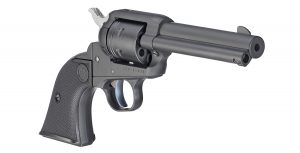
The Ruger Wrangler has pleasing traditional lines.(courtesy of Ruger)
There have been numerous variations on the Ruger Single Action including adjustable sights for the .22 and a fixed sight cowboy version of the Blackhawk known as the Vaquero. In 1973 the transfer bar system came into use. We now have a true six-shooter safe to carry fully loaded. The Ruger Single Six is among my favorite .22 plinkers. The Single Six is accurate enough for small game hunting and offers an excellent platform for first time shooters. By the same token many very experienced shooters prefer the Single Six .22.
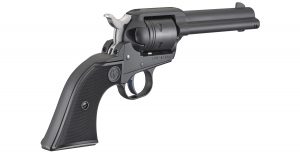
The Ruger Wrangler is a fixed sight single action revolver in the traditional manner, with a modern transfer bar ignition that allows carrying six cartridges in the cylinder safely.(courtesy of Ruger)
A challenge to shooters is justifying the cost of a quality .22 revolver. A good quality .22 costs about the same as a quality single action .45 and shooters just don’t like to pony up the bucks for a rimfire-although many do. Small caliber doesn’t always equal a small price tag. Machining bar stock steel and fitting action parts requires just as much labor and machine work with the Single Six as the Ruger Vaquero. The Single Six is a quality revolver that will last several lifetimes. There are less expensive revolvers and Ruger has introduced the Wrangler to compete in this niche.
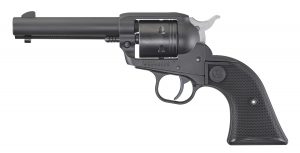
While the piece is made of inexpensive material the Wrangler performs well.(courtesy of Ruger)
It’s an economy-priced revolver with the same dimensions as the Single Six. Even the grip frames of the Single Six and the Wrangler are identical, and upgrades are readily available. The non-fluted cylinder is steel and so is the 4.62-inch barrel, and the ejector rod, cylinder pin, frame assembly pins, most screws and internal action parts are the same as the Single Six. The Wrangler features a transfer bar safety and a loading gate lock to prevent the hammer from being cocked if the loading gate is open, and holsters for one will fit the other.
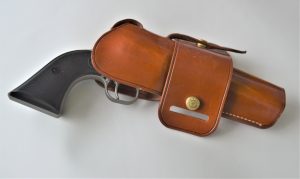
The Wrangler is a good fit for the Galco Wheelgunner holster.
Considering the material used, the absence of a .22 Magnum version is understandable. The .22 Magnum generates a lot of pressure compared to the .22 Long Rifle. While the unfluted cylinder looks good it is less expensive to finish than a cylinder with machine cuts. The cylinder doesn’t click from one station to the other on loading but is freewheeling. Sights are fixed, which is fine for most uses. The frame and loading gate are made from high grade aluminum, but other handguns including the SIG P series and any number of .38 revolvers use an aluminum frame. Aluminum is less expensive than steel and easier to machine.
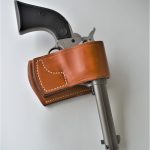
Rock K Saddlery’s belt slide is a great field holster.
The grip frame is a zinc alloy. This is the same material from which millions of inexpensive pocket pistols were made. Ruger does it right and the material looks good and feels right.
The hammer and trigger are metal injected molded stainless. This material has been used in 9mm and .45 caliber handguns without complaint. While some “cheap” guns are made from this material, the Wrangler is a well-made revolver with inexpensive components. These materials cost a fraction of the price of steel and they are well turned out by skilled workmen and women.
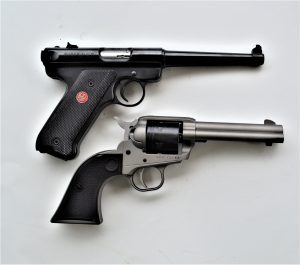
The Wrangler compared to the classic Ruger Standard Model.
The Wrangler wears a Cerakote finish, made from ceramic and polymer. I was surprised to learn the Wrangler features this finish, as it isn’t usually found on inexpensive handguns. Burnt Bronze, black and silver are the initial offerings. The fit and finish of the revolver is nice, and more than what would be expected from a handgun that should retail for less than $250. The Wrangler is two ounces lighter than the Single Six at 30 ounces and it has a good balance.
Firing Versatility
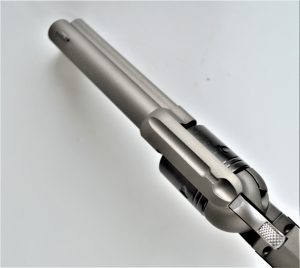
The Wrangler features a simple groove rear sight. The sights proved well regulated for 40 grain ammo.
The .22 revolver will use ammunition that will choke a self-loader. Birdshot, low velocity loads. 22 Short and any manner of target loads are well suited to .22 revolver use. When testing for accuracy the 4.8-pound trigger is manageable if not light and crisp.
While I settled into the bench rest firing position and fired for accuracy this just isn’t what the Ruger Wrangler is about. I have used several loads in the Wrangler with good results. Among these are the Winchester Wildcat and the 975 fps Super X 37-grain hollow point. This is a fine small game load that offers good performance at a fair price. The Wranglers fixed sights are happily well regulated for 40 grain .22 Long Rifle loads.
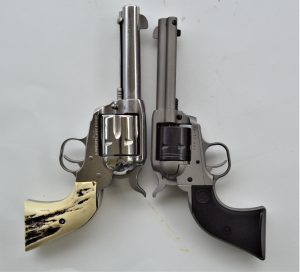
The Wrangler, right, is an understudy to the author’s New Vaquero in .45 Colt.
The Wrangler can deliver five shots into a group of 2.0 to 2.2 inches at 20 yards with attention to detail. This is more than adequate for most uses. The Wrangler is at its best as a fun gun for plinking. As such it did well and provided several hours of pure fun, firing over 350 mixed rounds without complaint. That takes a while with a single action revolver, opening the loading gate, ejecting rounds, and then reloading. But I had help and the Ruger made for a fun day of shooting.
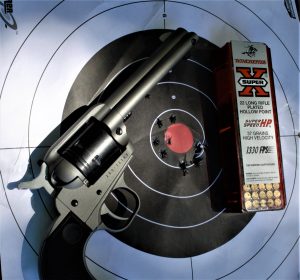
The author’s sliver Cerakote revolver is one of several available finishes. With Winchester ammunition the revolver performed well.
I used the GALCO Wheelgunner holster for most of my field shooting. I also used a Yaqui slide from Rocking K Saddlery. Crafted for the SAA this holster is a good fit for the Ruger Wrangler. The Wrangler is a good choice for the beginning shooter or for those who have wished to own a ‘cowboy’ gun without the expense of a center fire. The price is right and the quality is good.



